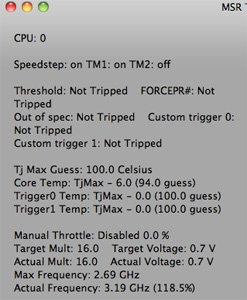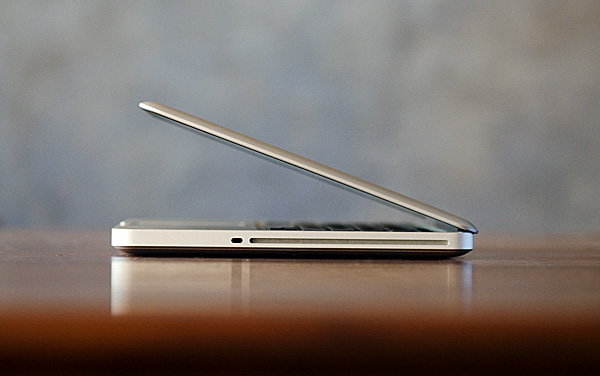The MacBook Pro Review (13 & 15-inch): 2011 Brings Sandy Bridge
by Anand Lal Shimpi, Brian Klug & Vivek Gowri on March 10, 2011 4:17 PM EST- Posted in
- Laptops
- Mac
- Apple
- Intel
- MacBook Pro
- Sandy Bridge
What About The 13?
Apple's new 13-inch MacBook Pro received the biggest upgrade of the lot. Last year Apple opted against moving the 13-inch model to Arrandale and instead gave it a beefy GPU and a mildly evolved Core 2 Duo CPU. The presumed public reasoning was Apple didn't like Arrandale's GPU performance and needed a two chip solution to maintain the platform's size hence the NVIDIA GT 330M + Intel Core 2 Duo setup. Internally I'm wondering if there was a small amount of corporate politics being played there. Apple used to get a discount on Intel CPUs in exchange for exclusivity, that agreement expired with Nehalem. When Nehalem hit, Apple had to pay the same price as everyone else for CPUs. Now does the 2010 Core 2 based 13-inch MacBook Pro make more sense? Keeping Intel's flagship CPU out of Apple's highest volume MacBook Pro had to hurt. I wonder if Apple got discounted pricing on Sandy Bridge as a result...
| Evolution of the 13-inch MacBook Pro | Early 2011 | Mid 2010 | Late 2009 |
| CPU | Intel Core i5 2.3GHz (DC) | Intel Core 2 Duo 2.40GHz (DC) | Intel Core 2 Duo 2.26GHz (DC) |
| Memory | 4GB DDR3-1333 | 4GB DDR3-1066 | 2GB DDR3-1066 |
| HDD | 320GB 5400RPM | 250GB 5400RPM | 160GB 5400RPM |
| Video | Intel HD 3000 (integrated) | NVIDIA GeForce 320M (integrated) | NVIDIA GeForce 9400M (integrated) |
| Optical Drive | 8X Slot Load DL DVD +/-R | 8X Slot Load DL DVD +/-R | 8X Slot Load DL DVD +/-R |
| Screen Resolution | 1280 x 800 | 1280 x 800 | 1280 x 800 |
| USB | 2 | 2 | 2 |
| SD Card Reader | Yes | Yes | Yes |
| FireWire 800 | 1 | 1 | 1 |
| ExpressCard/34 | No | No | No |
| Battery | 63.5Wh | 63.5Wh | 60Wh |
| Dimensions (W x D x H) | 12.78" x 8.94" x 0.95" | 12.78" x 8.94" x 0.95" | 12.78" x 8.94" x 0.95" |
| Weight | 4.5 lbs | 4.5 lbs | 4.5 lbs |
| Price | $1199 | $1199 | $1199 |
While the 15-inch MacBook Pro is quad-core only, the new 13 is strictly dual-core. You get two options: a 2.3GHz or 2.7GHz dual-core Core i5 or Core i7. In Intel speak it's the Core i5-2410M or the Core i7-2620M (it's no wonder Apple doesn't list model numbers for these things).

The 2011 13-inch MacBook Pro Motherboard
| Apple 13-inch 2011 MacBook Pro CPU Comparison | ||||
| 2.3GHz dual-core | 2.7GHz dual-core | |||
| Intel Model | Core i5-2410M | Core i7-2620M | ||
| Base Clock Speed | 2.3GHz | 2.7GHz | ||
| Max SC Turbo | 2.9GHz | 3.4GHz | ||
| Max DC Turbo | 2.6GHz | 3.2GHz | ||
| GPU Base Clock Speed | 650MHz | 650MHz | ||
| GPU Max Turbo | 1.2GHz | 1.3GHz | ||
| L3 Cache | 3MB | 4MB | ||
| AES-NI | No | Yes | ||
| VT-x | Yes | Yes | ||
| VT-d | No | Yes | ||
| TDP | 35W | 35W | ||
The primary differences between these two parts are clock speed, L3 cache size and AES-NI support once again. The 2.3GHz Core i5 lacks AES-NI, has a 3MB L3 cache and can only turbo up to 2.9GHz. The 2.7GHz Core i5 has AES-NI, a 4MB L3 cache and can turbo up as high as 3.4GHz.

I verified turbo frequencies on the 2.7GHz 13-inch. The highest I saw single core turbo hit was 3.4GHz, and dual core turbo was good for 3.2GHz. There's absolutely no funny business going on here, the dual-core 2.7 is allowed to hit its maximum frequencies.

You'll notice that the 2.7GHz DC chip has the same max single core turbo as the 2.3GHz QC chip from the upgraded 15-inch MacBook Pro. In practice this means that for light workloads the upgraded 15 won't feel any faster than the 13 (or that the 13 will feel as fast as the 15 depending on how you look at it). I'm talking about things like web page load times and application launch/install times. There may even be a slight performance advantage for the 13-inch setup as it's able to turbo up to higher frequencies easier than the quad-core 15. Crank up the threads and you've got a different story entirely of course. There's no replacement for more cores on highly threaded workloads.











198 Comments
View All Comments
Wolfpup - Friday, March 11, 2011 - link
Just LOOK at that. Visually it just makes things look worse...looks like it's taking up space for maybe two more cores, or a fifth core and more cache, or something.The only good thing about it is it may help AMD get back in the game. Assuming Bulldozer ends up relatively competitive, AMD's going to be able to have more cores or cache in the same die space, or else have a smaller CPU with the same performance.
Personally I'm a big fan of Intel's rock solid stability, but it feels like AMD gets better and better with that, where they feel like a real competitor now, and I'd love to see them get parity with Intel or even surpass them!
To people who have called the higher end config's GPU "high end", it's not. It's a decent mid range part. For the price it ought to have better...maybe that on the low end config and an 800 core part on the high end config (or a Geforce GTX 460), but at least it's a big jump up from the last gen models.
Belard - Saturday, March 12, 2011 - link
UH... and what reliability issues are you talking about with AMD? What, intel never screws up? I buy, own and sell both brands.Wardrop - Friday, March 11, 2011 - link
To be honest, I'm somewhat surprised that Apple don't offer a solution for reducing cable clutter, given their minilast design of the iMac, etc. A docking station sounds like an obvious solution. I'm sure Apple could come up with a really elegant way of docking your Macbook, or otherwise, just connecting all your cables via one main connection.I envisage a magnetic solution. You could either have a docking station, where the Macbook sits on something (a stand would be nice). Otherwise, a breakout box type of device, where you plug all your audio, USB and display cables into it, and then attach the breakout box to a single interface on your Macbook, whether it be a plug on the back, the side, or even a magnetised strip on the bottom of the notebook?
I use my Macbook Pro primary as a desktop. It goes through my desktop KVM, to which my Windows desktop is also connected. I try to avoid unplugging my Macbook from my desk however, simply because it's a hassle. I not only have to unplug the cables, but I have to eject my external time machine drive. One of the most annoying things I find however, is that because the screen resolution on my MBP is significantly lower than my desktop monitor, it often screws up all the windows. I find I need to spend time resizing all my windows for the 13" MBP display, and then have to do the same when I connect it back up to my 24" desktop monitor. When you've got 10+ windows all perfectly arranged to suit your working style, it's a major pain, hence I avoid taking my MBP off the desk.
tzhu07 - Sunday, March 13, 2011 - link
I was thoroughly unhappy with the current offerings for a docking station for my late 2006 macbook pro, and so I decided to go to home depot and build one myself. And I made it super elegant and wirefree. Also helps that my monitor is connected to an arm, keyboard wireless, and also mouse is wireless too.http://www.majorindulgence.com/file_exchange_data/...
ahhhhhhhhhhh.....super clean
bronze5420 - Friday, March 11, 2011 - link
this is definitely the best computer review i have ever read. very informative. answered all the questions i had and then some. keep up to good work. and does anybody know if OSX Lion will feature TRIM support for third party SSD's?13579abc - Friday, March 11, 2011 - link
First let me echo the sentiment of gratitude expressed throughout this forum. AnandTech really is a cut above other tech sites.Second, if I may add my two cents, heat and noise are such an important part of the mobile experience that they might deserve a little additional attention in this review, particularly given that apple tries to differentiate itself from competitors in these areas. This review touches on the surface temperatures of these new Macbook Pro models, but I wonder if there are any plans to more thoroughly examine surface temperatures in different areas of the notebook (i.e. palm rests, keyboard, bottom surface…). Also, does AnandTech have any comment on the effect of inappropriate quantities of thermal paste reportedly used in the notebooks? Some forum posts report amazing thermal improvements resulting from properly applying new thermal paste, but to be honest I have some doubts regarding the validity of these posts and think that they might be misleading.
Along similar lines are there any plans for a quantitative analysis of the noise output from these new models.
Again,thanks for a great review.
tipoo - Saturday, March 12, 2011 - link
Seconded, some numbers on thermals and decibels would be nice.Balfa - Saturday, March 12, 2011 - link
I've just bought the new 17" that I use mainly for software development but even at 1920x1200 it is a little on the cramped side. So at home I connect it to a Cinema Display 27'' via mini DP cable to the new combo TB-MiniDP port. And the monitor cable use also a Magsafe connector and lastly a usb2 for camera, sound and 3 usb ports at the back of the monitor like most folks already know likely.Now what I really wish for the future Apple is extends that paradigm of a monitor-docking station with a new 27'' monitor with only the Magsafe and one Thunderbolt cable. At the back of the monitor implements every ports that could be needed: USB3, FW800 (1600 maybe why not), eSATA (unlikely I know). And lastly add a powerful discrete GPU in the monitor itself with a quick access door to upgrade it if needed. That way you could remove the one in the MBP for lower cost and better battery life and still have a powerful GPU solution at home for gaming, transcoding and the like.
I think the monitor is the best place for docking a laptop, not needs for a separate device. I already put all my external disks behind it anyways (I place my monitor in the middle of the desk so there's a lot of empty space behind) and it will be the shortest route to plug them, less clutter that way. Gee it's a great idea isn't it!
MrBrownSound - Saturday, March 12, 2011 - link
Once again anandtech pulls off a amazing review. With this information I can cofortably say I will wait for Lion to come out.ProDigit - Saturday, March 12, 2011 - link
None of these machines is worth their price!The 13" has a price of a 16" laptop